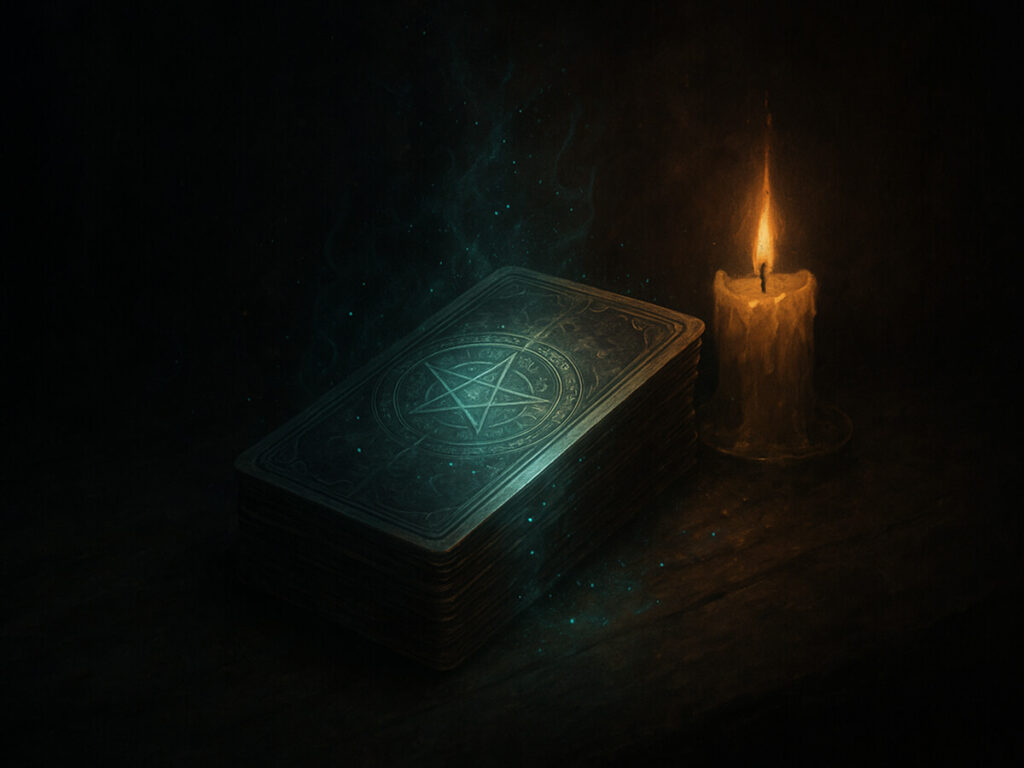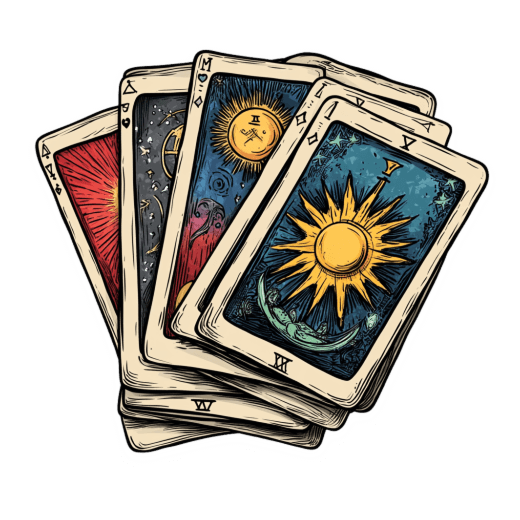Top 5 Tarot Spreads for Facing Your Shadow Self


Table of Contents
Hello there, dear seeker. It warms my heart to see you exploring this path. Over my many years reading the cards – goodness, has it really been over four decades? – I’ve found that one of the most profound journeys we can undertake is the one into our own shadows. Now, I know “shadow work” sounds a bit spooky, doesn’t it? Like something lurking under the bed! But truly, it’s nothing to fear. Think of it more like exploring the parts of your inner landscape that haven’t seen much sunlight lately.
Carl Jung, a very insightful man, talked about this “shadow self.” It’s essentially all the bits and pieces of us that we’ve tucked away, perhaps because we felt ashamed, embarrassed, or were told they weren’t acceptable. Maybe it’s a flash of anger you quickly suppress, a deep-seated fear you pretend isn’t there, or even a creative talent you dismissed long ago. We all have these hidden corners. It’s just part of being human, you see.
Why bother digging around in the shadows, you might ask? Well, ignoring these parts doesn’t make them go away. Oh no. They tend to pop up unexpectedly, sometimes tripping us up or influencing our choices without us even realizing it. Doing shadow work, really looking at these aspects with honesty and compassion, is how we start to heal old wounds. It’s how we become more whole, more self-aware. It’s like finally understanding why you keep reacting a certain way in relationships, or why you hold yourself back from pursuing a dream. It’s powerful stuff! I remember a client years ago, utterly baffled by her recurring self-sabotage, until we gently explored a childhood belief she’d completely forgotten. The relief on her face when the connection clicked… well, that’s why this work matters.
And that’s where our beautiful tarot cards come in. Tarot is such a wonderful companion for this journey. The images, the symbols… they speak a language that bypasses our logical minds and goes straight to the heart of things, to the subconscious where these shadows often reside. The cards don’t judge. They simply reflect, offering insights and perspectives we might not see otherwise. They can illuminate the path, showing us where a shadow might stem from and how we can begin to integrate it, not banish it, but understand and accept it as part of our unique tapestry. It’s a gentle, intuitive way to start this important conversation with yourself. Are you ready to shine a little light?
Preparing for Your Shadow Work Tarot Reading
Alright, before we dive into the spreads themselves, let’s talk about setting ourselves up for a meaningful reading. Think of it like preparing a cozy space for a heart-to-heart chat with a dear friend – in this case, that friend is your own deeper self. You wouldn’t try to have a serious conversation in the middle of a noisy market, would you? Same principle applies here. Find a time and place where you won’t be interrupted. Maybe it’s early morning with a cup of tea, or late evening when the house is quiet. Just make sure it feels peaceful and safe for you.
Now, grounding. This is so important, especially when we’re venturing into potentially sensitive territory like shadow work. It just means bringing yourself fully into the present moment, feeling steady. I often just take a few slow, deep breaths, feeling my feet on the floor. Simple, right? Sometimes I’ll light a candle or hold a favorite crystal, whatever helps me feel centered and calm. You don’t need anything fancy, truly. Just a moment to quiet the mental chatter before you shuffle your cards.
Next up is intention. Why are you doing this reading today? What part of your shadow are you curious about? Maybe you’ve noticed a pattern you want to understand, or perhaps there’s a specific feeling like envy or resentment you want to explore. Take a moment to gently focus your mind. You could even say it out loud or write it down: “I wish to understand my fear of vulnerability,” or “Show me what I need to know about my inner critic.” Having a clear, gentle intention helps guide the reading and makes the card messages much easier to interpret. It’s like giving the universe – and your subconscious – a little nudge in the right direction.
Let’s talk decks! I get asked this a lot – “Do I need a special, dark, spooky deck for shadow work?” My answer is always a gentle no. The most important thing, honestly, is using a tarot deck that speaks to you. One you feel comfortable with, whose images resonate. If you have a deck you love and know well, that’s perfect. If you’re drawn to a particular deck for this work, that’s fine too, but don’t feel obligated to buy something new. Your connection with the cards is what matters most. I’ve used the same slightly worn Rider-Waite deck for decades for all sorts of readings, shadow work included!
One last, very important thought before we proceed. Tarot is an incredible tool for self- discovery and gaining insight. It truly is. But please remember, it’s a guide, a mirror, not a replacement for professional mental health support. If you’re dealing with deep trauma or serious mental health concerns, please reach out to a qualified therapist or counselor. Tarot can be a wonderful complement to therapy, but it doesn’t take its place. Be gentle with yourself, always.
Simple Tarot Spreads to Gently Begin Your Journey
Now, let’s dip our toes into the water, shall we? Shadow work doesn’t have to be this huge, overwhelming plunge into the abyss right away. Sometimes, the gentlest approach is the most effective, especially when you’re just starting out or feeling a bit tender. I always tell my students, think of it like getting to know someone new – you start with simple questions, right? These first two spreads are like that: simple, focused, and designed to offer a clear starting point without feeling too intense. They only use three cards each, which is lovely because it keeps things manageable and prevents you from getting lost in too much information at once.
Remember that feeling when you first learned to ride a bike? A little wobbly, maybe a bit scared, but also excited? That’s kind of how starting shadow work can feel. These simple spreads are like having training wheels – they offer support and clarity as you find your balance. Don’t underestimate the power of three cards; sometimes the most profound insights come from the simplest layouts. I recall a time I was feeling particularly stuck, just vaguely out of sorts, and a quick three-card pull like the first one below cut right through the fog. It pinpointed an old insecurity I thought I’d dealt with, showing me it still needed a little attention. Amazing how that happens!
Spread 1: Basic Shadow Insight (3 Cards)
This is a wonderful starting point if you just have a general sense that something needs looking at, but you’re not sure what. Shuffle your cards while thinking gently about wanting to understand your shadow self better. When you feel ready, draw three cards and lay them out left to right.
- Card 1: What aspect of my shadow needs attention now? This card helps identify the specific theme or energy within your shadow self that’s currently asking for your awareness. It might be a fear, a belief, a pattern – the card will offer a clue.
- Card 2: What is the root or origin of this shadow aspect? Where did this begin? This card often points towards a past experience, a learned behavior, or an underlying wound that contributed to this shadow forming. Understanding the origin is key to compassion.
- Card 3: What is one step I can take towards integration? This is your gentle guidance forward. It suggests a practical, manageable action or shift in perspective you can take to begin acknowledging and working with this shadow aspect.
Spread 2: Acknowledging Repression (3 Cards)
This spread is helpful if you suspect you might be pushing something down or denying a part of yourself. Sometimes we do this without even realizing it! Again, shuffle with intention, focusing on uncovering what might be hidden. Lay out three cards.
- Card 1: What am I currently repressing or denying? This card directly addresses what you might be keeping hidden, even from yourself. Be open to what it reveals; it might surprise you.
- Card 2: What past wound or experience caused this repression? Similar to the previous spread, this delves into the ‘why’. What happened that made you feel you needed to hide this part of yourself away?
- Card 3: Advice for working with this shadow aspect to grow. This card offers guidance on how to approach this repressed part. It might suggest acceptance, expression, understanding, or another path towards healing and growth.
Take your time with these. Look at the images, feel into the energy of the cards, and journal about what comes up for you. No rush, no pressure. Just gentle exploration.
Comprehensive Spreads for Exploration
Feeling a bit more comfortable now? Perhaps those initial explorations sparked your curiosity, and you feel ready to delve a little deeper. That’s wonderful! Sometimes, after acknowledging the surface, we feel a pull to understand the nuances, the connections, the fuller picture. These next spreads use six cards, allowing for a more comprehensive look at a particular shadow aspect. They require a bit more time and reflection, so make sure you have that quiet space we talked about earlier. Don’t feel pressured to jump here too soon; the simple spreads are perfectly valid and powerful on their own. But if you’re feeling the call to explore further, these can offer some truly rich insights.
I remember working with these more detailed spreads when I was first seriously tackling my own patterns around, well, let’s just say needing to be right all the time. Oh, the energy I wasted! A simple spread showed me the pattern, but it took a deeper dive, much like these layouts, to really unpack why it was there and how it was connected to other fears. It wasn’t easy, mind you – shadow work rarely is – but it was incredibly freeing in the end. These spreads can help facilitate that kind of deeper understanding.
Spread 3: Starting the Process (6 Cards – inspired by Hermit’s Mirror)
This spread is excellent when you have a specific issue or feeling you want to work with, or even if you just want a clearer picture of what shadow aspect is most prominent right now. It helps you understand the shadow, its effects, and how to begin the process of integration. Lay the cards out perhaps in two rows of three, or any way that feels intuitive to you.
- Card 1: What do I need to know about this part of my shadow? This card offers a core insight or perspective on the shadow aspect you’re focusing on.
- Card 2: What is it preventing me from accessing? Shadows often hold blocked energy or potential. This card reveals what positive quality, strength, or experience is being hindered by this shadow.
- Card 3: How does this shadow manifest as a problem? How does this show up in your daily life? This card points to the tangible behaviors, thoughts, or situations where the shadow’s influence is felt.
- Card 4: What’s a good next step to bring this shadow to light? Practical guidance on how to begin acknowledging and working with this shadow consciously.
- Card 5: How can I most usefully approach this shadow work? What mindset or attitude will best serve you in this process? (e.g., patience, curiosity, courage).
- Card 6: What can I expect to feel in the early phase? Shadow work can stir things up. This card offers a heads-up on the emotions or challenges that might arise as you begin.
Spread 4: Bringing Shadow Into The Light (6 Cards – inspired by Backyard Banshee)
This spread focuses beautifully on identifying how you might be holding yourself back and how to move towards integration with self-compassion. It’s about understanding the harm caused by suppression and finding ways to empower yourself. Again, lay them out in two rows or a circle, whatever feels right.
- Card 1: In what ways am I holding back that is causing me harm? This directly addresses self-limiting patterns connected to the shadow.
- Card 2: How can I hold myself with more love and compassion right now? A crucial reminder for the journey – how to be kind to yourself through this process.
- Card 3: What shadow aspect am I avoiding most? Sometimes the thing we resist most holds the key. This card points to that area of avoidance.
- Card 4: In what ways is it manifesting that I may not be aware of? Shadows are sneaky! This card reveals subtle or unconscious ways the shadow is influencing you.
- Card 5: How can I best integrate this shadow? What does integration look like for this specific aspect? Acceptance? Expression? Understanding?
- Card 6: In what ways will integration help with empowerment and life improvement moving forward? This card shows the positive potential and growth that comes from embracing this part of yourself.
Remember to breathe as you explore these cards. Journal your thoughts, feelings, and any memories that surface. This is your journey, your timing. Be patient and kind to yourself above all else.
Unique Approaches: Creative Shadow Work Tarot Techniques
Now, while structured spreads are incredibly helpful, sometimes a different approach can unlock insights in a surprising way. Tarot is wonderfully flexible like that! Not everything needs to fit neatly into a positional layout. Over the years, I’ve found a couple of more intuitive, creative techniques that can be really potent for shadow work. Think of these as less of a map and more of a conversation starter with your subconscious. They invite reflection and journaling in a slightly different way, sometimes getting right to the heart of an issue with startling clarity.
One involves paying attention to our visceral reactions to the cards themselves – those gut feelings we often try to ignore. Another leans into seeking guidance from that deeper wisdom within or the guides we work with. I find these methods particularly useful when I feel a bit stuck with traditional spreads or when I want to explore a feeling or reaction that doesn’t quite fit a standard question. It’s like trying a different key when the first one doesn’t turn the lock, you know? Sometimes the side door is the way in!
Technique 1: The Card You Dislike Exercise
This one is fascinating, if sometimes a little uncomfortable! Go through your tarot deck, card by card. Take your time. Which card gives you that little jolt of negativity? Which one makes you think, “Oh, not that one!”? There might be more than one, but try to pick the one that evokes the strongest aversion right now. Don’t judge yourself for it! Just notice. This card often holds a significant clue about your shadow.
Once you have your card, sit with it. Look at the imagery. What specifically bothers you? Is it the character, the action, the perceived meaning? Now, grab your journal and explore:
- Why this strong dislike? What thoughts or feelings immediately come up?
- What fears does this card trigger in you? Be honest.
- Does this card remind you of any past experiences, situations, or people?
- Is the fear it represents based on a current reality, or is it an old echo? Is it a valid concern, or perhaps a limiting belief?
- If the fear feels valid, how could you create more safety or agency around it?
- If it feels like an old echo or limiting belief, how might you begin to gently challenge or release it?
This exercise is powerful because our strong aversions often point directly to something within ourselves we’ve disowned or judged harshly. That card you hate? It might just be reflecting back a part of your own shadow waiting for acknowledgement.
Technique 2: Talking To Your Guides
Sometimes, we need a little outside perspective, even if that perspective comes from our own higher self or the spiritual guides we connect with. This spread facilitates that conversation, focusing specifically on getting guidance for your shadow work journey. Set the intention to connect with your wisest, most compassionate inner guidance or your spirit team.
- Card 1: Spirit guide’s energy. A card representing the energy or aspect of guidance available to you now.
- Card 2: Issue they can help me with. What specific shadow aspect or challenge is this guidance focused on?
- Card 3: Block to resolving the issue. What’s getting in the way of healing or integration?
- Card 4: How to change perspective. A new way to look at the issue that can unlock progress.
- Card 5: How to heal the issue. Guidance on the healing process itself.
- Card 6: Other guidance. Any additional wisdom or encouragement your guides want to offer.
This approach shifts the focus slightly from self-analysis to receiving wisdom. It can feel very supportive and less isolating, reminding us we’re not alone on this path. Trust the messages that come through, even if they seem subtle at first.
Integrating Insights & Practicing Self-Compassion
So, you’ve done a reading, the cards are laid out, and insights are bubbling up. What happens next? Well, the reading itself is just the beginning, my dear. The real magic happens in the integration – how we take those messages from the cards and weave them into our understanding and our lives. It’s not always about having a dramatic epiphany right then and there. More often, it’s a quieter process of letting the insights settle and unfold over time.
Journaling is your best friend here. Seriously. Right after a reading, while the feelings and thoughts are fresh, write it all down. Don’t censor yourself. What did you feel when you saw that card? What memories popped up? What connections did you make? Even if it feels confusing or contradictory, get it on paper. I find that looking back at my tarot journal days or even weeks later often reveals connections I missed in the moment. The subconscious keeps working long after the cards are put away!
And please, let’s talk about those “scary” cards – the Tower, the Devil, the Ten of Swords. It’s natural to feel a jolt when they appear, especially in a shadow work reading. But try, gently, to resist seeing them as purely negative omens. In shadow work, these cards often represent the very core of the issue needing attention. The Tower might signify a necessary breakdown of old structures or beliefs related to your shadow. The Devil can point to feelings of bondage, addiction, or materialism tied to that hidden aspect. The Ten of Swords, while looking dramatic, often speaks of hitting rock bottom with a certain pattern – which means the only way is up! See them as signposts pointing to where the deepest healing is needed, not as prophecies of doom. Explore their symbolism in the context of your question with curiosity, not fear.
Integration also means looking for small, actionable steps. Did the cards suggest a need for more self-care? Maybe that translates to scheduling just 15 minutes of quiet time each day. Did they point to a fear of speaking up? Perhaps the step is simply noticing, without judgment, when you silence yourself in conversations. It doesn’t have to be huge. Small, consistent shifts, inspired by the tarot’s guidance, create lasting change. It’s about translating the symbolic language of the cards into the practical language of your life.
Most importantly, throughout this entire process, practice radical self-compassion. Shadow work can bring up uncomfortable feelings – sadness, anger, shame, grief. That’s okay. It’s normal. Be as kind and patient with yourself as you would be with a beloved friend going through a difficult time. If you feel overwhelmed, take a break. Rest. Do something nurturing. This isn’t a race or a competition. It’s a journey of returning to wholeness, and that requires immense tenderness towards yourself. Remember that client I mentioned, the one with the self-sabotage? A huge part of her healing was learning to forgive herself for the pattern, not just understand it. Compassion is the balm that allows true integration to happen.
Embracing Your Whole Self Through Tarot
And so, we come to a pause in our exploration, though the journey itself continues. We’ve talked about the shadow self – those hidden parts of us yearning for acknowledgement – and how our wise tarot cards can act as gentle guides, illuminating the path towards understanding and integration. From simple three-card check-ins to deeper, more comprehensive spreads and creative techniques, tarot offers so many ways to engage in this profound work of self-discovery.
Remember, the goal isn’t to eliminate the shadow; that’s impossible, and frankly, undesirable! Our shadows hold immense energy, resilience, and hidden gifts. The journey is about integration, about bringing these aspects into the light of conscious awareness so they no longer unconsciously run the show. It’s about embracing all of who you are, the light and the dark, with compassion and understanding. It leads to a more authentic, grounded, and fulfilling life. I’ve seen it time and time again over these many years – the quiet strength that emerges when someone truly accepts themselves, shadows and all.
Tarot is a beautiful companion on this path. It doesn’t give easy answers, but it reflects your own inner wisdom back to you. It encourages honesty, prompts reflection, and offers perspective when you feel lost in the fog. Trust the process, trust the cards, and most importantly, trust yourself. This work takes courage, yes, but the rewards – greater self-awareness, healing, and wholeness – are immeasurable.
So, I encourage you, dear reader, if you feel the nudge, try one of these spreads. See what messages await you. Be patient, be kind, and be curious. Perhaps you’ll share your journey in the comments below if you feel comfortable, or maybe you’ll simply hold the insights close as you continue your path. Whatever you choose, know that embarking on shadow work is a powerful act of love towards yourself. Keep shining your light.
Frequently Asked Questions
It warms my heart to see so much curiosity around this work! I often get asked similar questions by those starting their shadow work journey with tarot, so I thought I’d address a few common ones here.
Do I need a special tarot deck for shadow work?
Oh, heavens no, my dear. While some decks might be marketed that way, the absolute most important thing is using a deck that you feel connected to. One whose images speak to you, one you feel comfortable holding and shuffling. Whether it’s a classic Rider-Waite-Smith, a modern artistic deck, or one you’ve had for ages – if it resonates with you, it’s the right deck. Your personal connection and intuition are far more important than any specific aesthetic. Trust the deck that feels like an old friend.
What if I pull a scary or negative card during a shadow work reading?
Ah yes, the Tower tumbling down, or perhaps the Devil grinning at you! It’s natural to feel a little jolt. But please, try to see these cards not as bad omens, but as important messengers, especially in shadow work. They often point directly to the core of the shadow aspect needing your attention – the outdated belief that needs to crumble (Tower), the feeling of being trapped by a pattern or fear (Devil), or the painful end of a cycle that allows for rebirth (Ten of Swords). Instead of fearing a literal event, ask: What pattern is this card highlighting? What deep-seated belief is ready to be examined? These cards invite you to look deeper, often signifying where the most profound healing can occur.
How often should I do shadow work tarot spreads?
There’s no set schedule, truly. Listen to your own inner rhythm and intuition. Some people might feel called to explore weekly, others monthly, and some only when a specific issue strongly surfaces. The key is not frequency, but intention and integration. Doing readings too often without taking time to process the insights can just lead to confusion. It’s better to do one meaningful reading and spend time journaling and reflecting on it, than to do many readings superficially. Give yourself space to breathe and integrate between sessions. Quality over quantity, always.
Can tarot replace therapy for shadow work?
This is a very important distinction. Tarot is a truly wonderful tool for self-reflection, gaining insight, and connecting with your intuition. It can absolutely illuminate aspects of your shadow. However, it is not a substitute for professional mental health support. If you are dealing with deep-seated trauma, severe depression or anxiety, or other significant mental health challenges, please seek guidance from a qualified therapist or counselor. Tarot can be a beautiful complementary practice alongside therapy, helping you explore themes that arise, but it doesn’t replace the structured support and expertise a professional can offer. Please take good care of your mental and emotional well-being.






